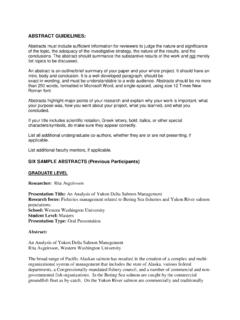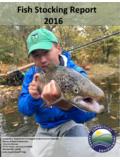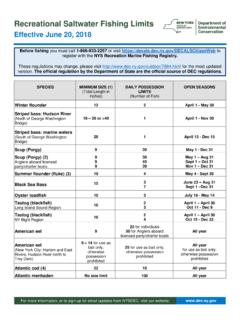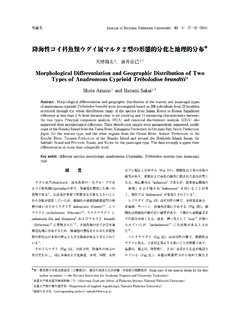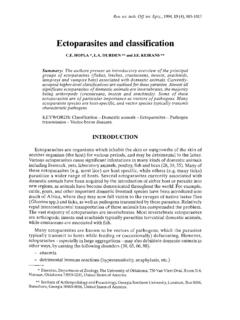Transcription of Tingue Dam Bypass Channel - Connecticut
1 1 Tingue DAM Bypass Channel NAUGATUCK RIVER, Connecticut Application for NOAA Coastal and Marine Habitat Restoration Project Grants Under the American Recovery and Reinvestment Act of 2009 1. Project Summary Applicant: Connecticut Department of Environmental Protection Bureau of Water Protection and Land Reuse, Planning and Standards Division 79 Elm Street, Hartford, CT 06106-5127 Project Title: Tingue Dam Bypass Channel Construction on the Naugatuck River, Seymour, CT Site Location: Naugatuck River, Seymour, CT Lat. 41deg 23min 35sec Long.
2 73deg 04min 34 sec Land Owner: Town of Seymour, CT Project Start Date: July 1, 2009 Construction Start Date: October - November, 2009 (Detailed schedule in text below) Number and types of jobs created or maintained and anticipated duration: Estimated to create or maintain construction, engineering, landscaping, and supporting services jobs involving 135 people and 36,569 hours of work. Coastal and marine habitats to benefit from the project: Riverine Migratory Corridors, diadromous fish habitat. The removal ( Bypass ) of Tingue Dam, an in-stream barrier to diadromous fish passage on the Naugatuck River, will immediately restore access to 32 miles of essential habitat for spawning, and juvenile rearing and growth of American shad, blueback herring, alewife and American eel, four species of regional and national significance.
3 The amount of miles in the mainstem between the Tingue Dam and the upstream Plume-Atwood Dam (targeted for eventual removal) is 24 miles and the amount of habitat initially opened on seven tributaries will be 8 miles, which will also increase when several targeted dams are eventually removed. The Naugatuck River watershed (310 square miles) joins the Housatonic River eight miles upstream from Long Island Sound, near the head of tide (Figures 1 and 2). In turn, the Housatonic River basin is the largest watershed with the greatest amount of historical diadromous fish freshwater habitat in the western Long Island Sound.
4 Passage around the Tingue Dam complements a series of eight dam removal and fish passage projects, including six on the Naugatuck River from Ansonia, CT, near the confluence of the Naugatuck and Housatonic Rivers, upstream approximately 23 miles to Thomaston, CT, and two on tributaries. The Naugatuck River, once dominated by untreated sewage and industrial waste, has undergone marked improvements in water quality and has become a coldwater fishing destination in Connecticut . The restoration of fish passage for anadromous herrings and searun brown trout will extend these improvements.
5 The Naugatuck River is a highly-urbanized watershed and will 2 afford greater access and value to urban residents for recreation and aesthetics in an economically disadvantaged area. Project Scope: The construction of the Tingue Fish Bypass represents a mid-scale, shovel-ready project that will yield significant and sustainable ecological and economic benefits. Feasibility studies, selection of a preferred alternative, final design, and necessary property easements, acquisitions and consents are complete. Permits required for the project are dam safety, flood management, 401 water quality, and Army Corps of Engineers (ACOE) programmatic general permit (PGP).
6 All had been previously issued, but must be renewed or reissued because expiration dates have passed. Since the applications and work scope has not changed significantly, all permits should be reissued by the proposed construction start date of October 2009. Major construction activities include creation of a fish Bypass Channel around the Tingue Dam on the Naugatuck River through excavation and removal of fill. The Channel will include habitat features to ensure diadromous fish passage success. The site will be stabilized and streamside habitat restored to promote infiltration of stormwater by the use of pervious paving and native vegetation landscaping techniques.
7 Post-construction activities will include monitoring the fishway in two ways: visual observations of fishes actively migrating up the fishway, and documentation of physical and hydraulic conditions (comparing design flow characteristics with actual flow characteristics). Current creel return assessments for sea-run brown trout will be extended upstream of the fishway as a measure of short-term socioeconomic benefits of the project. Project Output/Outcomes: Restoring diadromous fish passage at the Tingue Dam will restore access to 32 miles of historical spawning and juvenile rearing and growth habitats.
8 Diadromous species targeted for restoration include American shad (20,000 returning adults), river herring (blueback herring and alewife, collectively; 30,000 returning adults), sea-run brown trout (highly variable numbers impossible to accurate project), and American eel (very high numbers, impossible to estimate). The numbers of shad and river herring reflect long-term projections based upon estimates of what the full capacity of the restored habitat can support when the restored populations have reached equilibrium. This will occur long after the award period, perhaps as much as 20 years in the future.
9 In addition, the re-establishment of these self-sustaining populations will have many indirect ecological benefits such as increased populations of predators. These include osprey, bald eagle, striped bass, bluefish, seals, porpoises, colonial nesting birds, otter, and mink. Furthermore, diadromous fish are the vector for transporting many freshwater mussels to upper portions of watersheds. Since the construction of dams, many species of mussels have disappeared from upper watersheds and the construction of the Bypass will reverse this trend.
10 Project Timeline: The construction of the project is expected to begin approximately 90 days of the award upon approval of necessary permits (October 2009) and completed within 18 months of the project start date, with substantial completion within the first 12 months (Detailed schedule in text below). This project has been designed, and specifications have been prepared. Construction related permits (dam safety, flood management, 401 water quality, and ACOE PGP) that had been issued for the project have expired, and an expedited reissuance of them is anticipated within 90 3 days of project initiation (by October 1, 2009).












